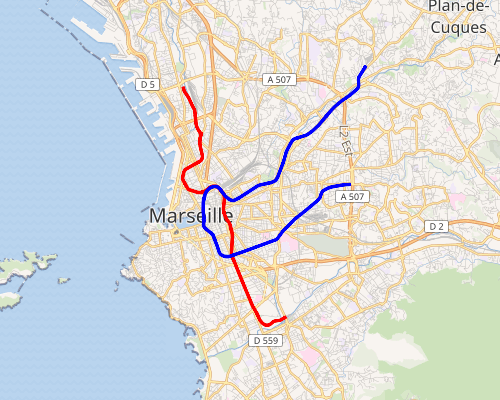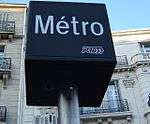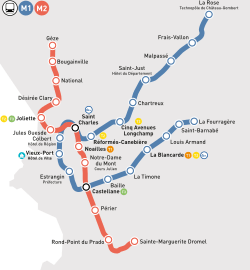Marseille Metro
The Marseille Metro (French: Métro de Marseille) is a rapid transit system serving Marseille, in Southern France. As of 2020, the system comprises two lines, partly underground, serving 29 stations, with an overall route length of 22.3 kilometres (13.9 mi).[1] Line 1 opened in 1977, followed by Line 2 in 1984. Two stations, Saint-Charles and Castellane, each provide interchange between lines.
.jpg) MPM 76 train at Saint-Barnabé station on Line 1 | ||||||||||||||||||||||||||||||||||||||||||||||||||||||||||||||||||||||||||||||||||||||||||||||||||||||||||||||||||||||||||||||||||||
| Overview | ||||||||||||||||||||||||||||||||||||||||||||||||||||||||||||||||||||||||||||||||||||||||||||||||||||||||||||||||||||||||||||||||||||
|---|---|---|---|---|---|---|---|---|---|---|---|---|---|---|---|---|---|---|---|---|---|---|---|---|---|---|---|---|---|---|---|---|---|---|---|---|---|---|---|---|---|---|---|---|---|---|---|---|---|---|---|---|---|---|---|---|---|---|---|---|---|---|---|---|---|---|---|---|---|---|---|---|---|---|---|---|---|---|---|---|---|---|---|---|---|---|---|---|---|---|---|---|---|---|---|---|---|---|---|---|---|---|---|---|---|---|---|---|---|---|---|---|---|---|---|---|---|---|---|---|---|---|---|---|---|---|---|---|---|---|---|---|
| Native name | Métro de Marseille | |||||||||||||||||||||||||||||||||||||||||||||||||||||||||||||||||||||||||||||||||||||||||||||||||||||||||||||||||||||||||||||||||||
| Locale | Marseille, France | |||||||||||||||||||||||||||||||||||||||||||||||||||||||||||||||||||||||||||||||||||||||||||||||||||||||||||||||||||||||||||||||||||
| Transit type | Rapid transit | |||||||||||||||||||||||||||||||||||||||||||||||||||||||||||||||||||||||||||||||||||||||||||||||||||||||||||||||||||||||||||||||||||
| Number of lines | 2[1] | |||||||||||||||||||||||||||||||||||||||||||||||||||||||||||||||||||||||||||||||||||||||||||||||||||||||||||||||||||||||||||||||||||
| Number of stations | 29[1] | |||||||||||||||||||||||||||||||||||||||||||||||||||||||||||||||||||||||||||||||||||||||||||||||||||||||||||||||||||||||||||||||||||
| Daily ridership | 210,200 (daily avg., 2012)[2] | |||||||||||||||||||||||||||||||||||||||||||||||||||||||||||||||||||||||||||||||||||||||||||||||||||||||||||||||||||||||||||||||||||
| Annual ridership | 76.7 million (2012)[2] | |||||||||||||||||||||||||||||||||||||||||||||||||||||||||||||||||||||||||||||||||||||||||||||||||||||||||||||||||||||||||||||||||||
| Operation | ||||||||||||||||||||||||||||||||||||||||||||||||||||||||||||||||||||||||||||||||||||||||||||||||||||||||||||||||||||||||||||||||||||
| Began operation | 26 November 1977 | |||||||||||||||||||||||||||||||||||||||||||||||||||||||||||||||||||||||||||||||||||||||||||||||||||||||||||||||||||||||||||||||||||
| Operator(s) | RTM | |||||||||||||||||||||||||||||||||||||||||||||||||||||||||||||||||||||||||||||||||||||||||||||||||||||||||||||||||||||||||||||||||||
| Technical | ||||||||||||||||||||||||||||||||||||||||||||||||||||||||||||||||||||||||||||||||||||||||||||||||||||||||||||||||||||||||||||||||||||
| System length | 22.3 km (13.9 mi)[1] | |||||||||||||||||||||||||||||||||||||||||||||||||||||||||||||||||||||||||||||||||||||||||||||||||||||||||||||||||||||||||||||||||||
| Track gauge | 1,435 mm (4 ft 8 1⁄2 in) standard gauge | |||||||||||||||||||||||||||||||||||||||||||||||||||||||||||||||||||||||||||||||||||||||||||||||||||||||||||||||||||||||||||||||||||
| ||||||||||||||||||||||||||||||||||||||||||||||||||||||||||||||||||||||||||||||||||||||||||||||||||||||||||||||||||||||||||||||||||||
The system's MPM 76 trains use the rubber-tyred metro technology developed by the RATP for some lines of the Paris Métro. In 2012, the Marseille Metro carried approximately 76.7 million passengers,[2] making it a core part of the transport network in the Marseille urban area, with 49% of journeys using the metro. Since 1986, the Régie des transports métropolitains (Régie des transports de Marseille until 2016) has operated the network, operating it since it changed its name on behalf of the Aix-Marseille-Provence Metropolis.
Timeline
| Date | Line | Event |
|---|---|---|
| 26 November 1977 | Line 1 | First section opened between La Rose and Saint-Charles |
| 11 March 1978 | Extended southwards from Saint-Charles to Castellane | |
| 3 March 1984 | Line 2 | Section opened between Joliette and Castellane |
| 1 February 1986 | Extended southwards from Castellane to Sainte-Marguerite Dromel | |
| 14 February 1987 | Extended northwards from Joliette to Bougainville | |
| 5 September 1992 | Line 1 | Extended eastwards from Castellane to La Timone |
| 5 May 2010 | Extended eastwards from La Timone to La Fourragère | |
| 16 December 2019 | Line 2 | Extended northwards from Bougainville to Gèze |
| Before 2030 | Planned extension eastwards from Sainte-Marguerite Dromel to Saint-Loup Pagnol with 6 new stations, between 4.1 kilometres (2.5 mi) and 4.6 kilometres (2.9 mi)[3] | |
| After 2030 | Line 3 | Planned opening between Luminy and Saint-Charles with 15 new stations, between 9.6 kilometres (6.0 mi) and 10 kilometres (6.2 mi)[3] |
History
The first plans for a metro system in Marseille appeared in the early years of the 20th century, following the opening of the Paris metro.[4] Many plans were put forward, but quickly abandoned due to lack of financing. The most serious proposal emanated in 1918 from the Compagnie d'électricité de Marseille, which proposed to build an underground network similar to the Paris métro. This proposal was met with fierce opposition from the Compagnie générale française de tramways, which owned and operated the city's tramway system. This project ultimately failed, and the idea of building a metro in Marseille was abandoned for many decades.
The tramway system, badly damaged during the Second World War, was almost completely scrapped during the 1950s and replaced by buses (with the exception of line 68). However, by 1960, the city was suffering from severe congestion due to the growth in automobile use. New metro projects resurfaced in the mid-1960s, as a means to alleviate traffic congestion. After several years of studies, the city council voted unanimously in 1969 for the creation of a metro system.[5]
Construction of the first line started on August 13, 1973 and lasted until early 1977.[6] Revenue operation started on November 26, 1977 on a portion of the line, between La Rose and Saint-Charles. The rest of the line opened on March 11, 1978. The plans for the second line were approved in 1978. Construction began in 1980.[7] The central portion of the line, between Joliette and Castellane, opened on March 3, 1984. Southern and northern portions of the line were opened in February 1986 and February 1987 respectively.
Subsequent extensions took place in the following years. Line 1 was first extended between Castellane and La Timone on September 5, 1992 (1.5 km, 2 new stations),[8] and then between La Timone and La Fourragère (2.5 km, 4 new stations) in 2010.[9] On 16 December 2019, line 2 was extended northwards from Bougainville to Gèze (0.9 km, 1 new station).[10]
Current network
Map

Rolling stock
The rolling stock comprises 36 4-car trains, named MPM 76.[11] Trains have a capacity of 472 passengers (including 182 seats). MPM 76 trains use the rubber tyre metro technology developed by the RATP for the Paris métro.
Trains were built in Valenciennes, France, by a group of French companies which are now part of Alstom group. A first batch of 21 3-car trains was delivered in 1976, for line 1. A second batch of 15 was delivered in 1983, for line 2. In 1985, a fourth car was added on every train, in order to increase capacity.
Commercial operation

The metro system is operated by the Régie des Transports Métropolitains, on behalf of the Urban Community of Marseille Provence Métropole, which owns the infrastructure as well as the rolling stock.
Service is open every day, from 5 am to 1 am the next day. Trains run every 3 minutes during rush hour, and every 10 minutes during evenings.
The metro system transported 76.7 million passengers in 2012,[2] leading to an average daily ridership of over 210,000.
Planned developments
A 900-metre (0.56 mi) long extension of line 2 to Capitaine Gèze is expected to open in 2019, north of the current terminus station Bougainville.[12][13][14] The new Capitaine Gèze station will feature a bus station and a park and ride facility. This short extension will reuse existing service tracks that currently lead to the Zoccola depot. The cost is estimated to be 80 million euros.
Several other long-term extensions, including a southern extension of line 2 from Sainte-Marguerite to St-Loup, are being considered.
In 2012, it was projected that the MPM76 rolling stock would be replaced starting in 2020, but there have been no further plans to do this since.[15]
References
- "Fiche d'identité de l'Entreprise - LE METRO" [ID card of the company - THE METRO]. rtm.fr (in French). Retrieved September 28, 2013.
- "Fiche d'identité de l'Entreprise - LE TRANSPORT AU COEUR DE NOTRE MISSION : Un Réseau Intégré" [ID card of the company - TRANSPORT AT THE HEART OF OUR MISSION: An Integrated Network]. rtm.fr (in French). Retrieved September 28, 2013.
- "Marseille: Le prolongement de la ligne 2 du métro vers le sud sur de bons rails". 20 Minutes. December 13, 2016.
- (Laupiès 1993, pp. 49–56)
- (Laupiès 1993, pp. 71–81)
- (Laupiès 1993, pp. 81–86)
- (Laupiès 1993, pp. 86–95)
- (Laupiès 1993, pp. 104–114)
- Jean-Jacques Fiorito (May 5, 2010). "Marseille : le métro s'offre quatre nouvelles stations". La Provence (in French).
- RTM (December 16, 2019). "Prolongement de la ligne de métro M2 à Gèze" (in French).
- Bochet, Henri (March 1980). "Le métro de Marseille". Revue générale des chemins de fer (in French). Dunod: 139–146. ISSN 0035-3183.
- "Annoncée en 2015, la station Gèze déraille jusqu'à septembre 2019 | Marsactu". Marsactu (in French). May 23, 2018. Retrieved June 12, 2018.
- Vinzent, Julien (June 6, 2011). "Bus, cars, voitures et vélos auront rendez-vous au futur métro capitaine Gèze". www.marsactu.fr. Archived from the original on December 31, 2011.
- Fiorito, Jean-Jacques (September 27, 2011). "Marseille : et voici le futur terminus de la ligne 2 du métro". La Provence (in French).
- Vinzent, Julien (May 25, 2012). "Le renouvellement du métro coûtera "plusieurs centaines de millions d'euros"". www.marsactu.fr (in French). Archived from the original on June 2, 2012.
Bibliography
- Laupiès, Jacques (1993). Marseille et son Métro (in French). Éditions Paul Tacussel. ISBN 2903963665.
- Groneck, Christoph (2006). Metros in France. Robert Schwandl Verlag. ISBN 978-3936573138.
External links
![]()
- Marseille Metro Map on Google earth with geolocation
- RTM – official website (in English)
- Marseille at UrbanRail.net (in English)
